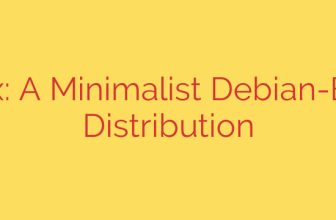
Streamline Your Alerts: A Deep Dive into ntfy, the Simple Pub-Sub Notification Service
In today’s interconnected world, notifications are the lifeblood of our digital systems. From a failed server backup to a completed software build, timely alerts are crucial. However, setting up notification systems can often be a complex process involving proprietary apps, convoluted APIs, and expensive services. What if there was a simpler, more flexible way to send push notifications to your phone or desktop from virtually any script or application?
Enter ntfy, an open-source, HTTP-based publish-subscribe notification service that prioritizes simplicity and control. Whether you’re a developer, a system administrator, or a tech hobbyist, ntfy offers a powerful and straightforward solution for all your alerting needs.
What is ntfy? Understanding the Pub-Sub Model
At its core, ntfy operates on a publish-subscribe (or “pub-sub”) model. Imagine it like a radio station. A broadcaster (the “publisher”) sends out a message on a specific frequency (a “topic”). Anyone with a radio (a “subscriber”) tuned to that frequency will receive the message. You don’t need to know who the listeners are; you just broadcast to the channel.
ntfy applies this elegant concept to digital notifications.
- Topics are simple URLs: You don’t need to register or configure topics beforehand. You simply invent a topic name, like
https://ntfy.sh/my-server-alerts. This URL is now your dedicated channel. - Publishing is an HTTP request: To send a notification, you just send an HTTP POST request to your topic’s URL. This can be done easily with command-line tools like
curlor from any programming language. - Subscribing is easy: You can listen for notifications on a topic using the ntfy web app, a dedicated Android or iOS app, or by integrating it with your own applications.
This approach makes it incredibly easy to integrate notifications into any workflow without needing complex libraries or SDKs.
Getting Started: Your First Notification in Seconds
The best way to understand ntfy’s simplicity is to see it in action. You can use the free, public ntfy server at ntfy.sh to test it right now.
Step 1: Subscribe to a Topic
Open a web browser and navigate to a topic of your choice. Let’s use https://ntfy.sh/your-test-topic123 (be sure to use a unique name). You can also download the ntfy app for your phone and subscribe to the same topic there.
Step 2: Publish a Message
Now, open a terminal and run the following curl command:
curl -d "My first test notification is working." ntfy.sh/your-test-topic123
Instantly, you will see the message “My first test notification is working” appear in your web browser and as a push notification on your phone. It’s that simple.
Powerful Features Beyond Basic Alerts
While the basic functionality is incredibly straightforward, ntfy is packed with features that provide granular control over your notifications.
- Message Priority: Not all alerts are created equal. You can set a priority level from 1 (min) to 5 (max/urgent) to control how notifications are delivered. Urgent messages can override silent modes on your phone, ensuring you never miss a critical event.
- Titles and Tags: Organize your alerts by adding titles and tags (including emojis). This makes it easy to identify the source or category of a notification at a glance, such as a server icon for infrastructure alerts or a checkmark for successful tasks.
- File Attachments: Need to send a log file, a screenshot of an error, or a data report? ntfy allows you to attach files to your notifications, making it a powerful tool for remote debugging and monitoring.
- User Actions: Make your notifications interactive. You can add action buttons that trigger a URL or execute a command. For example, a “disk space low” alert could have an action button to “View Dashboard” or “Run Cleanup Script.”
Common Use Cases for ntfy
The flexibility of ntfy makes it suitable for a wide range of applications.
- CI/CD Pipeline Notifications: Get instant alerts when a build succeeds, fails, or a deployment is complete.
- System Monitoring and Alerts: Integrate ntfy with your monitoring tools (like Nagios, Zabbix, or simple cron jobs) to send alerts for high CPU usage, low disk space, or service downtime.
- Script and Automation Feedback: Receive a notification when a long-running script, such as a database backup or data processing job, has finished.
- Personal Reminders and IFTTT: Because it’s just an HTTP endpoint, you can connect it to countless services and devices to create custom reminders and alerts for anything you can imagine.
The Importance of Self-Hosting and Security
The public server at ntfy.sh is fantastic for testing and non-sensitive notifications. However, it’s crucial to remember that topics on the public server are, by default, public. Anyone who guesses your topic name can subscribe to it or send messages to it.
For any private, sensitive, or business-critical notifications, self-hosting your own ntfy instance is the recommended approach. This gives you a completely private and secure notification environment. Setting up a self-hosted instance is incredibly simple, especially with the official Docker image. A self-hosted server provides:
- Complete Privacy: Your topics and messages are only accessible on your own server.
- Full Control: You can configure user access, require authentication, and manage your own data.
- No Rate Limits: You are only limited by the capacity of your own hardware.
By self-hosting, you gain the power and simplicity of ntfy without compromising on security. It’s the perfect solution for creating a robust, private, and highly effective notification system for all your projects.
Source: https://www.linuxlinks.com/ntfy-simple-http-based-pub-sub-notification-service/








